An Elastocaloric Calorimeter
January 13, 2020
I've always enjoyed doing simple
benchtop experiments, especially those that can be assembled from
household items (at least in my high-tech household with an
electronics workshop). There might be some
nostalgia in this, since I spent my
childhood working on one
science fair experiment after another.
Physicist and
Nobel Laureate,
Ernest Rutherford (1871-1937), was famous for building
experiments from common articles such a piece of a
bicycle handlebar,
string, and
sealing wax.[1] The official
cost of construction of the
Large Hadron Collider, including
research and development,
testing, and pre-operation, was nearly
$5 billion, and this is probably a conservative
estimate.[2] You can buy a lot of
test tubes and
pan balances for that amount of money.
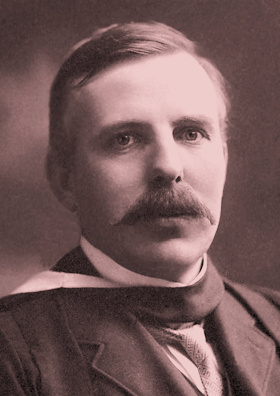
Although Ernest Rutherford (1871-1937) was a physicist, he was awarded the 1908 Nobel Prize in Chemistry. This must have reinforced his belief that serious science is all physics.
Rutherford is famous for the discovery of the proton, and as Director of the Cavendish Laboratory of Cambridge University in 1932 when James Chadwick discovered the neutron.
While not much string and sealing wax are used in today's laboratories, they've been replaced by items such as WD-40, super glue, and my favorite, five-minute epoxy.
(Wikimedia Commons image, modified for artistic effect.)
In the
previous article (Elastocaloric Effect, November XX, 2020), I described recent experiments on the
elastocaloric effect in which
rubber releases
heat when
stretched, and then absorbs heat when allowed to
relax. This is a manifestation of a change in the
material entropy caused by changes in the
alignment of
molecules. Since I've had experience in
calorimetry,[3] I decided to assemble a simple elastocaloric calorimeter using materials available in my home workshop. Numbers are one thing, but I didn't realize how small this effect was until I did some experiments.
The layout of my calorimeter is shown in the figure. The inner and outer
cylindrical containers were made from
vitamin and
dietary supplement containers of appropriate sizes. To enhance
sensitivity, I made the
water bath that receives heat from the stretched
rubber bands as small as possible. A simple mechanism allows
twisting the rubber band by
rotation at the top against a fixture at the bottom. A
motorized stirer is used to uniformly transfer heat to the water bath, and a
resistor is placed for
calibration by passage of an
electric current for a set time. The
photograph gives detail of the construction.
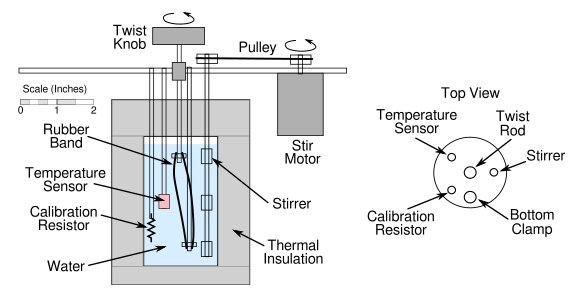
Calorimeter layout. The inner container sits on a sheet of Styrofoam, while fiberglass is used as the remainder of the insulation material. There's a mechanism that holds the twist knob in place when the desired number of turns is reached. (Created using Inkscape. Click for larger image.)
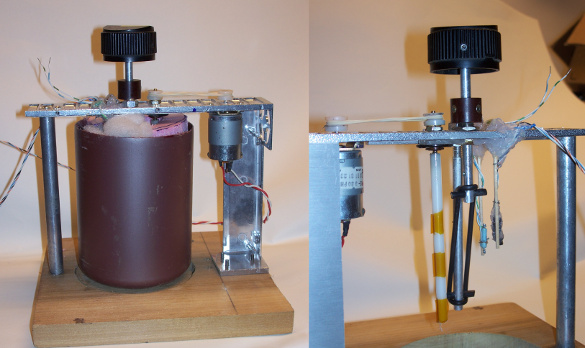
Photograph of the calorimeter, and a detail view of the interior components. In this case, a Buna-N O-ring is mounted on the torsion assembly. Since it's always desirable to minimize heat leakage to the environment, the calibration resistor and temperature sensor are suspended on thin wooden rods, and the stirer is Delrin. Unfortunately, mechanical strength is needed in the twist assembly, so quarter-inch diameter aluminum rods are used. (Click for larger image.)
Some of my experiments in the
1970s involved sitting in front of an
analog voltmeter and taking
data in a
laboratory notebook.
Computers have made
data acquisition much easier, and I have a
12-bit analog-to-digital converter that attaches to a computer
serial port. I realized that I needed more
resolution than 12-bits could provide, so I built a
circuit, shown below, that
amplifies the
signal from a
semiconductor temperature sensor by a factor of ten to give an effective 15-bit resolution. One caveat of the circuit is that the
rail-to-rail operational amplifiers function well only in their mid-range, so I "zeroed" the differential signal at mid-range and not at zero volts.
Offset and calibration were handled by
software.
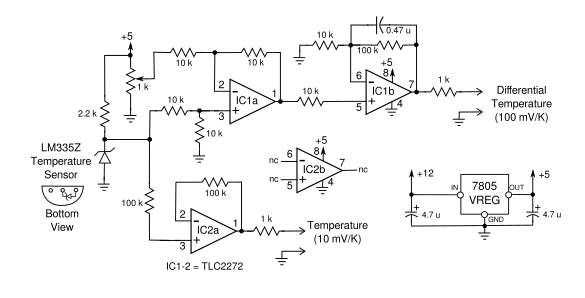
Calorimeter circuit. The LM335Z is a convenient temperature sensor, and it has an output voltage that's proportional to the absolute temperature. (Click for larger image.)
In my experiments, the calorimeter was calibrated by application of ten volts to a 50
ohm resistor for one minute. This produced a heat
pulse of 120
joules. The rubber bands that I used were
natural rubber, 3-1/2
inch circumference by 1/2 inch width, with a 2.5
gram weight (
Staples #84). To maximize response, one band was placed inside another to give a combined weight of 5 grams. The data for one experiment in which a doubled band was twisted and untwisted 50 turns is shown below.
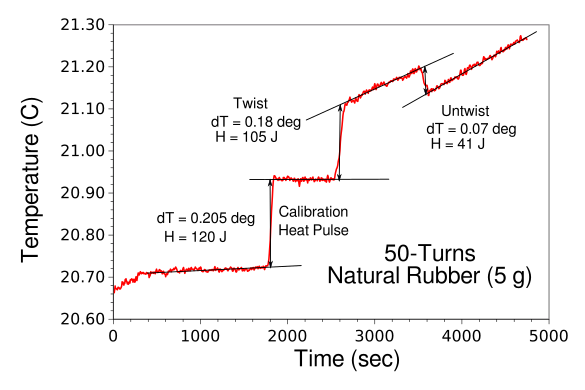
Elastocaloric effect experimental data. Even the best calorimeters give data on a drifting baseline, and the usual method for extracting the data is shown. It's easily seen that twisting and untwisting do not produce the same heat, a consequence of the heat produced by friction, as explained in the text. (Graphed using Gnumeric. Click for larger image.)
According to the elastocaloric effect, heat is released when a rubber band is stretched, and then absorbed when the stretch is relaxed. It can be seen from the above data that the measured heats are different. The problem is the
friction produced when the rubber strips
rub against each other. As can be seen in the photograph, there's a lot of rubbing.
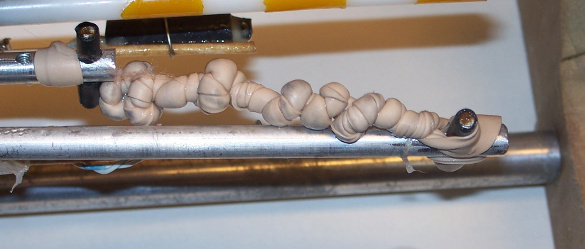
Rubber bands twisted 40 turns in the calorimeter. These bands break at about 60 turns, so 50 turns were used to give maximal effect.
This rubbing is the same during twisting and untwisting, and this allows elimination of the frictional heat
F in a
calculation of the elastocaloric heat
H.
Twisting: H + F = 105 j
Untwisting: H - F = 41 j
H = 73 j
H = 14.6 j/g
This elastocaloric specific heat, 14.6 j/g, is close to that reported in similar experiments.[4-5] As you can see, this effect is very small.
References:
- Ashutosh Jogalekar, "Ernest Rutherford, master of simplicity," Scientific American Blogs, August 30, 2013.
- Facts and Figures about the LHC, CERN Website.
- D.M. Gualtieri and P.J. Ficalora, Electron Transfer and Metallic Bonding: The Heats of Reaction of FeAl3-x(Ag;Zn;Pt;Au)x Alloys, High Temperature Science 7, 25-36 (1975).
- Run Wang, Shaoli Fang, Yicheng Xiao, Enlai Gao, Nan Jiang, Yaowang Li, Linlin Mou, Yanan Shen, Wubin Zhao, Sitong Li, Alexandre F. Fonseca, Douglas S. Galvão, Mengmeng Chen, Wenqian He, Kaiqing Yu, Hongbing Lu, Xuemin Wang, Dong Qian, Ali E. Aliev, Na Li, Carter S. Haines, Zhongsheng Liu, Jiuke Mu, Zhong Wang, Shougen Yin, Márcio D. Lima, Baigang An, Xiang Zhou, Zunfeng Liu, and Ray H. Baughman, "Torsional refrigeration by twisted, coiled, and supercoiled fibers," Science, vol. 366, no. 6462 (October 11, 2019), pp. 216-221, DOI: 10.1126/science.aax6182.
- George Musser, "A fridge made from a rubber band? Twisted elastic fibers could cool your food," Science, October 10, 2019, doi:10.1126/science.aaz8133.
Linked Keywords: Workbench; benchtop; experiment; household hardware; household item; electronics; workshop; nostalgia; childhood; science fair; physicist; Nobel Prize in Chemistry; Nobel Laureate; Ernest Rutherford (1871-1937); experiment; bicycle handlebar; fiber; string; sealing wax; cost of construction; Large Hadron Collider; research and development; evaluation; testing; dollar; $5 billion; cost estimation; test tube; pan balance; science; physics; proton; director; Cavendish Laboratory; Cambridge University; James Chadwick; neutron; WD-40; cyanoacrylate; super glue; five-minute epoxy; Wikimedia Commons; elastocaloric effect; natural rubber; heat; deformation (mechanics); stretch; relaxation (physics); material; entropy; alignment; molecule; calorimetry; cylinder (geometry); cylindrical; vitamin; dietary supplement; sensitivity (electronics); laboratory water bath; rubber band; torque; twist; rotation; electric motor; motorize; agitator (device); stirer; resistor; calibration; electric current; photograph; calorimeter; Styrofoam; fiberglass; thermal insulation; material; Inkscape; nitrile rubber; Buna-N; O-ring; thermal conductivity; heat leakage; environment (biophysical); calibration; temperature sensor; wood; polyoxymethylene; Delrin; mechanical strength; diameter; aluminum; 1970s; analog voltmeter; data; laboratory notebook; desktop computer; data acquisition; 12-bit; analog-to-digital converter; serial port; resolution; electronic circuit; amplifier; amplify; signal (electrical engineering); semiconductor device; rail-to-rail operational amplifier; baseline; oOffset; software; output voltage; proportionality (mathematics); proportional; thermodynamic temperature; absolute temperature; ohm; pulse (physics); joule; inch; circumference; gram; weight; Staples #84; drift (telecommunication); drifting baseline; friction; Gnumeric; rub; calculation.